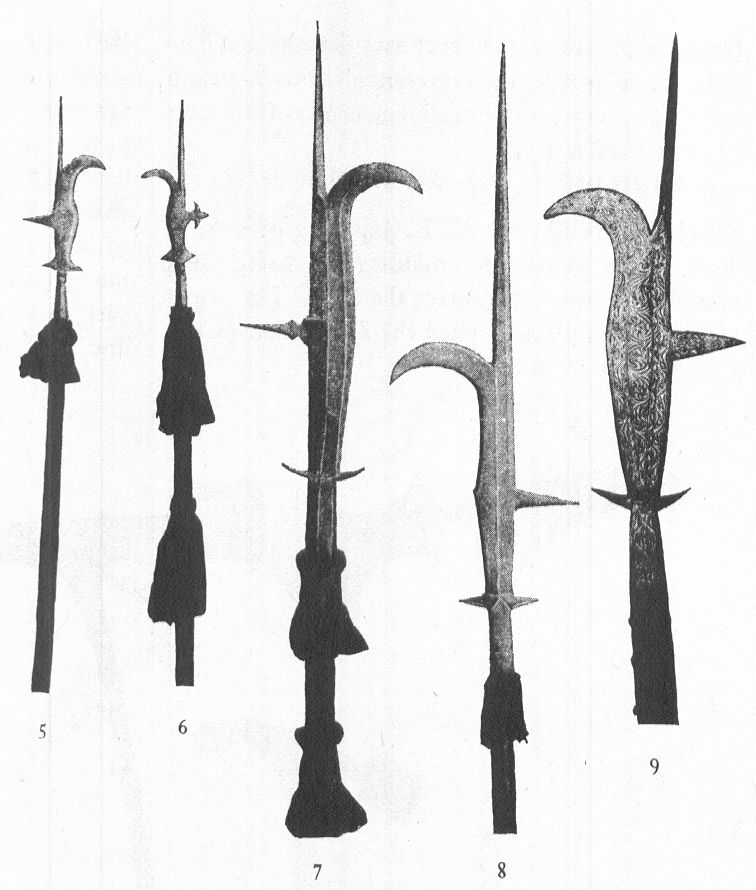I'd say the reality is somewhere in the middle; and I also think that this is the accepted history of the Medieval sword. The sword was a status symbol for, among other things, the costs and craftsmanship involved. But it was also a very effective and very versatile weapon;
Which tended to chip and break a lot and wasn't effective vs. armor unless specifically designed for it - with a tapered tip, see some of the variants on previous page.
No need to romanticize it, you get enough of this shit from the katana folk (although not from the ones who have actually used it on stuff).
how often exactly. If a sword got chipped in one several hour long battle, not much of a biggie, I'd say. Not if it actually did a good job at what it was intended to do - and I see no reason to doubt that atm. If it broke or got noticeably chipped halfway through, you'd probably have scrounged around for a dead guy's weapon - that kind of thing was far from unheard of AFAIK. And WHY did swords get chipped or broke? Because they were of shoddy craftsmanship/ the design of the weapon was shit? Or rather because people actually swung them with a lot of force - because they
could penetrate armor in that case.
The versality of the sword is there, but if you face guys in armor, you may want to opt for a specialized tool for the job and save yourself the bother.
If you have a specialized combat role, then this is probably what is going to happen, yes. In this regard, I'd assume that spear type weapons actually were specialist weapons in the Middle Ages. Not in the sense that they took a huge amount of training or physical conditioning to use properly, but in that they were lacking exactly that versatility that e.g. the sword was offering.
In ancient times, maybe you could wield a short spear and a shield throughout an entire battle while remaining engaged on the field. Maybe. But that would have changed with the widespread use of effective armor. Now a one-handed stab wouldn't do much of anything anymore unless you lucked out and took out someone's eye. At the very least, you'd have to use both hands to have a chance to break through armor. And a two-handed spear type weapon would have been anything but versatile at that point in time.
But armor =/= armor, not everyone had access to the same kind of armor, and you need to get your autistic head out of the notion that we're just talking about the Late Middle Ages when swords not coincidentally started to disappear. You have ancient sources describing long Celtic swords that couldn't be used for stabbing (unrealistic as that claim may be) but were very effective in individual combat; you have ample evidence of the Roman gladius that was anything but a show weapon as far as we know; and you have descriptions of people fighting with swords in battle throughout the Middle Ages, from the Franks to the heavily armored cavalries of the High Middle Ages, who surprisingly enough, were still carrying swords.
So you'll have to make clear what angle you're coming from before carrying on this discussion makes any sense, because you keep moving the goal posts here.
- are you claiming swords were only show items, that they were useful in individual combat but not on the battlefield, that they were useful on the battlefield but not equally useful in all situations? Which is it?
- are you claiming that conflicts have always been resolved by arming lots of people with more easily manufactured weapons, like the spear? If so, are you proposing masses of rudimentarily trained soldiers, or was there some conspiracy to mask the fact that professional soldiers were already strictly using specialist weapons on the battlefield throughout the Middle Ages, but the individual combatant got romanticized by stressing the importance of a versatile weapon like the sword? Which is it?
- are you claiming that armor offered equal levels of protection throughout the Middle Ages, and that therefore certain weapons were never really useful? If so, what level of protection do you propose for the Middle Ages? Something a sword couldn't penetrate? If so, why could a spear penetrate armor that a sword couldn't?
- are you claiming equal levels of quality/ penetrative power for each weapon type throughout the Middle Ages, everywhere (in Europe)? If so, describe exactly what armor could be penetrated with, let's say, just the sword and spear respectively, or more weapons, at your leisure.
We don't really have a useful debate here before you clear this stuff up.
seems like we have to sort out our definitions again.
https://en.wikipedia.org/wiki/Bill_(weapon)
That shit… is just a hook on a pole. No point at the top. No curved blade remotely comparable to the design of an effective axe. They call it "a hooked chopping blade", but was the end opposite the hook even actually honed for chopping in all cases? I repeat, this is a fishing implement used for hauling in people.
Yay, Wikipedia images.
Handful of different weapons from different times and places.jpg
well, that resolves exactly nothing, but thanks for the pretty pictures.
A weapon with a short point on top and another short point facing down, now that at least makes some sense as far as penetrating metal armor goes, which is usually what is ascribed to those weapons. It would still be a specialist weapon, that is, serve a specialized purpose. Still not something highly trained troops would bother with because it wouldn't require that much training. Basically, you're a can opener.
Your grandma's old city guard would be exactly the kind of goofball who really really wants that impressive looking weapon that those impressive looking elite soldiers are carrying, without having the physique or training for it, let alone actual applications in the cramped confines of a city. A somewhat long spear and some short blade for close quarter fighting would be just fine. Instead him and his drinking buddies are now carrying a long spear with an axe head on it that they couldn't use effectively if their lives depended on it - literally.
And that's... because you say so? Or is this some sort of gamist trope, where city guard is there to take a beating and be useless? They might as well could, if the region was peaceful and they didn't see any action, but that applies to all kinds of fightning men.
Historically, there were all kinds of militias out there, and the italian city-state militias were pretty damn impressive.
Strictly speaking, a city guard could be anyone. Could be militia (not too likely in pre-Renaissance times I guess). Could be someone in the employ of the city/ some local noble. Could be soldiers from a garrison nearby.
As you may have realized, the city guard of a city
state might just be… the regular armed forces in that place. They may see action in the field regularly. Even the elite troops in that place may be roaming the city, official guard duty or no. That doesn't make a spear-axe-hook transforming weapon any more useful or realistic though.
Stronger blows are telegraphed (that's how the body works) and can be anticipated
--> speaking from your experience with the standardized human body, apparently.
No need to get upset, I can see you don't have any background in any kind of a martial art, but that too is all right.
You can tell me about your relevant martial arts background if you like. I'm pretty sure it's Armchair-Fu though. You also completely missed the point in the same go, grats.
Yes, humans tend to telegraph their movements in one way or another - shifting balance, changing stance, flinching, it really depends.
Good fighter will train to minimize that and reading your opponent is an important part of combat.
"I can safely move in the way of this guy's blade. He flinched while lifting it up. Don't nobody gotta fear a flincher."

This shit is getting hilarious, keep going. Also, again, you completely missed the Point. I acknowledged the existence of telegraphing while pointing out that "bro it's all in the telegraphing" is a typical armchair bullshit explanation. The physical properties of the human fist and the lightly clothed human body tend to be largely the same; different People facing off with different weapons while wearing different armor, now that's a real toughie when it comes to telegraphing. But apparently, you don't even understand telegraphing. You were using telegraphing as an explanation for why people would have deliberately allowed themselves to be hit by the enemy's weapon; when in reality, reading the enemy's movements to predict the direction of the blow and its point of impact to dodge/ block it or, way better yet, to predict a hole in his defense and then exploit it to kill him would be both safer and way more effective. That is in fact what martial Artists do, they don't try to decide wether they should just take that blow.




















